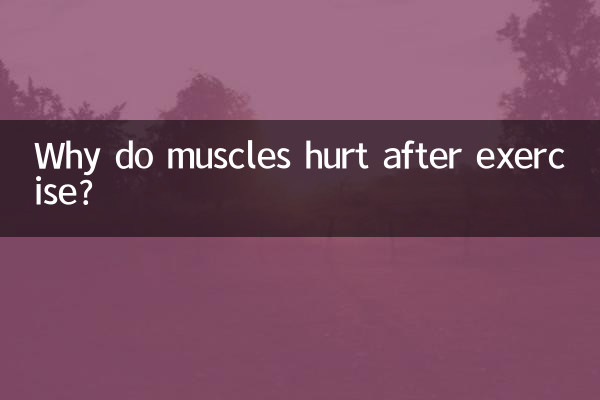Why do muscles hurt after exercise?
Muscle pain after exercise is a common phenomenon for many people, especially when they first start exercising or when they suddenly increase the intensity of exercise. This pain is often calledDelayed onset muscle soreness (DOMS), usually peaking within 24-48 hours after exercise. The following is a detailed analysis of muscle pain after exercise, combined with hot topics and hot content on the Internet in the past 10 days.
1. Causes of Delayed Onset Muscle Soreness (DOMS)

The main cause of DOMS is microscopic damage to muscle fibers during exercise, which triggers an inflammatory response and repair process. The following are common causes that may cause DOMS:
| Reason | Description |
|---|---|
| Sudden increase in exercise intensity | The body does not adapt to the new exercise load, resulting in muscle fiber damage |
| eccentric contraction exercise | Activities such as running downhill and squatting are more likely to cause DOMS |
| Not exercising for a long time | Muscles that have not been stimulated for a long time can easily lead to soreness due to sudden movement. |
| Insufficient recovery after exercise | Lack of stretching, nutritional supplements, or sleep |
2. How to relieve muscle pain after exercise
While DOMS cannot be completely avoided, you can relieve pain and speed recovery by:
| method | Effect |
|---|---|
| light activity | Low-intensity exercise such as walking and swimming can promote blood circulation |
| Stretching and Massage | Relieve muscle tension and reduce soreness |
| Replenish protein and water | Helps muscle repair and prevents dehydration |
| alternating hot and cold therapy | Ice compresses reduce inflammation and heat compresses promote blood circulation. |
| Get enough sleep | Sleep is a critical period for muscle repair |
3. Popular sports topics on the Internet in the past 10 days
Combined with recent hot topics on the Internet, the following are hot discussion topics about muscle pain after exercise:
| topic | heat index |
|---|---|
| How to recover quickly after exercise | ★★★★★ |
| Scientific explanation of DOMS | ★★★★☆ |
| The best time to replenish nutrition after exercise | ★★★★☆ |
| Stretching vs. Massage: Which Is More Effective? | ★★★☆☆ |
| Does pain after exercise mean good results? | ★★★☆☆ |
4. Common misunderstandings about pain after exercise
There are many misconceptions about muscle pain after exercise. The following are common misunderstandings in recent popular discussions:
| Misunderstanding | facts |
|---|---|
| The stronger the pain, the better the effect | Excessive pain may be a sign of injury, not a sign of effectiveness |
| Complete rest is the best way to recover | Mild activity is better for recovery than complete inactivity |
| Stretching immediately after exercise can prevent DOMS | Stretching can’t prevent DOMS, but it can relieve symptoms |
| Only novices get muscle soreness | Anyone who changes their exercise patterns may develop DOMS |
5. When Do You Need Medical Treatment?
Most DOMS resolves on its own within 3-7 days, but the following conditions may require medical attention:
| Symptoms | Possible problem |
|---|---|
| Pain that lasts more than 7 days | Possible muscle strain or other injury |
| Joint swelling or limited movement | May be joint damage rather than simple muscle soreness |
| Urine becomes darker in color | Possible red flags for rhabdomyolysis |
| accompanied by fever or general malaise | Infection or other systemic disease may be present |
6. Recommendations for preventing muscle pain after exercise
Based on recent exercise science, here are some effective ways to prevent DOMS:
| Suggestions | Description |
|---|---|
| Gradually increase exercise intensity | Increase physical activity by no more than 10% per week |
| Warm up and cool down adequately before and after exercise | A 5-10 minute warm-up can significantly reduce the risk of injury |
| Maintain regular exercise habits | Exercise at least 3 times a week and avoid long interruptions |
| cross training | Alternate different exercises to avoid overuse of a single muscle group |
| Supplement adequate electrolytes | Especially sodium, potassium, magnesium, etc., help muscle function |
Muscle pain after exercise is a normal response of the body to adapt to new challenges, but understanding its causes and how to deal with it can help us exercise and recover more scientifically. Remember, pain should not be the only criterion for exercise. Gradual and scientific training is the key to healthy exercise.

check the details

check the details